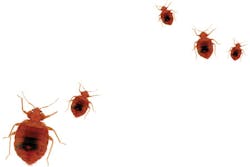By Noel Kelsch, RDH, RDHAP, MS
A reader recently posed the question: “We had a patient recently who was infested with bed bugs. Do we need to inform other patients? Can we legally ask this woman not to return to our office unless she’s treated for bed bugs?”
First and foremost, bed bugs (Cimex lectularius) do not ordinarily carry disease.1 They can live for months without food, just like cockroaches. They survive by being parasitic, feeding off people (and sometimes even animals) as they sleep. While some people have no symptoms of exposure to bed bugs at all, others get a rash or itching from the insect’s bite as it sucks blood. The bite marks are called pruriginous macules or papules. Some people can have serious allergic reactions to the protein in the bug’s saliva that causes the bite marks. If exposure continues, the person can end up with a fever and anemia.2
The Centers for Disease Control and Prevention (CDC) recommends the following wide range of treatment for the reactions:
- In many cases, antibiotics, antihistamines, topical and oral corticosteroids, and epinephrine have been used for bite reactions with varying results.
- With the more extensive or severe cases, topical steroid creams with or without systemic anti-H1 receptor antihistaminics may be given. Topical antiseptics or antibiotics as well as systemic antibiotics may be needed in the case of secondary infection.
The CDC also reports, “Treatment options for cutaneous and systemic reactions from bed bug bites have not been evaluated in clinical trials and there is no evidence that outcomes differ significantly from those receiving no treatment.”1,3
The bugs are flat, small bugs that range in size from 1mm to 7mm. Their color ranges from reddish brown, or a darker red depending on the amount of blood they have in them. They crawl around, but do not fly. Contrary to what many people believe, the insects are not a sign of being dirty and can occur even in the most prestigious of residences and hotels.
Typically, you will find them residing where people sleep. During the day, they infest places such as the seams of mattresses, chairs, or cluttered areas. They prefer dark, hidden places.
There is little chance that a dental patient would be “spreading” bed bugs to other patients. Bed bugs generally do not like to stay on humans. They like to be in dark places.
In outpatient settings such as emergency rooms and dental offices, if the patient needs to be seen immediately, the Centers for Disease Control states that the key is prevention. To prevent establishment of bed bugs, avoid wood furniture and fabric-covered furniture in the lobby. Use plastic encasement (barrier protection) for pillows, chairs, etc. Otherwise delay treatment until the issue has been resolved.4
You will need to check your waiting room furniture and your operatory chair for the following signs:
- The bed bugs’ exoskeletons after molting
- Bed bugs in the fold and joints of chairs
- Rusty-colored blood spots due to their blood-filled fecal material that they excrete on furniture
- A sweet musty odor1,5
If bed bugs are present in a dental office, you will need to get assistance from an exterminator. These little bugs are very resistant to pesticides. It is important to have a professional address the problem. They will first identify if the bug you have seen is a bed bug and apply the necessary steps to get rid of the bed bugs. Effective methods of eradicating these bugs are lacking. There are several issues surrounding getting rid of these insects; they are resistant to most insecticides, and there are health concerns about spraying mattresses or places where people are sit with pesticides.1,6 These are reasons why bed bug populations and infestations are on the rise both nationally and internationally.7,8
The reader’s questions above about being able to turn the patient away takes a few ethical directions:
What is the patient’s real needs? Your compassion and humane attitude may change this person’s life. You may be the person that makes a difference. If someone is walking around with bedbugs on their body they have a need that goes well beyond the dental chair.
This person could be dealing with everything from fever to anemia. They may not have the ability to address their own needs. This is where we come in. This is truly a case that needs to be referred to adult protective services. Referral for appropriate assistance and follow-up are a part of your role as providers.
Is the patient in the dental office for urgent treatment that need to be addressed immediately? If the treatment is urgent, then there are appropriate steps that can be taken to minimize contamination.
If, after you have taken all steps to meet needs of the patient and referrals, the patient does not follow through, you can dismiss the patient. There are many legal ramifications to dismissal of a patient. You would have to follow your state dental practice act regulations for dismissing a patient from your practice. You would want to consult your attorney and liability company before you dismiss the patient. This can differ from state to state. It is important that you dismiss without abandonment, giving reasonable notice to allow the patient to secure care and providing care for the allotted amount of time your state requires.
Our jobs do include meeting both the oral health needs and issues that impact the oral health needs of our patients. When a patient clearly does not have the ability to meet their own basic human needs, we need to be there to advocate for them.
Jason Woods is an attorney who specializes in the dental industry. When I inquired about this issue, his reply was, “The argument would be that the infestation endangers other patients and can lead to the spread of bedbugs in the local community due to the body laying on the same surface as other individuals, even though the dentist would be cleaning the chair after each patient.” Jason went on to say that it is the responsibility of all health-care providers to not transmit insects, viruses and bacteria from one source to another. RDH
NOEL BRANDON KELSCH, RDH, RDHAP, MS, is a syndicated columnist, writer, speaker, and cartoonist. She serves on the editorial review committee for the Organization for Safety, Asepsis and Prevention newsletter and has received many national awards. Kelsch owns her dental hygiene practice that focuses on access to care for all and helps facilitate the Simi Valley Free Dental Clinic. She has devoted much of her 35 years in dentistry to educating people about the devastating effects of methamphetamines and drug use. She is a past president of the California Dental Hygienists’ Association.
References
1. Goddard J, deShazo R. Bed bugs (Cimex lectularius) and clinical consequences of their bites. JAMA 2009;301(13):1358-66.
2. www.cdc.gov/parasites/bedbugs/faqs.html
3. www.cdc.gov/parasites/bedbugs/health_professionals/index.html
4. www.cdc.gov/parasites/bedbugs/add_resources.html
5. www.cdc.gov/parasites/bedbugs/biology.html
6. www.cdc.gov/mmwr/preview/mmwrhtml/mm6037a1.htm?s_cid=mm6037a1_e
7. CDC, Environmental Protection Agency. Joint statement on bed bug control in the United States from the U.S. Centers for Disease Control and Prevention (CDC) and the U.S. Environmental Protection Agency (EPA). Atlanta, GA: US Department of Health and Human Services; 2010.
8. Romero A, Potter MF, Potter DA, Haynes KF. Insecticide resistance in the bed bug: a factor in the pest’s sudden resurgence? J Med Entomol 2007;44:175--8.







